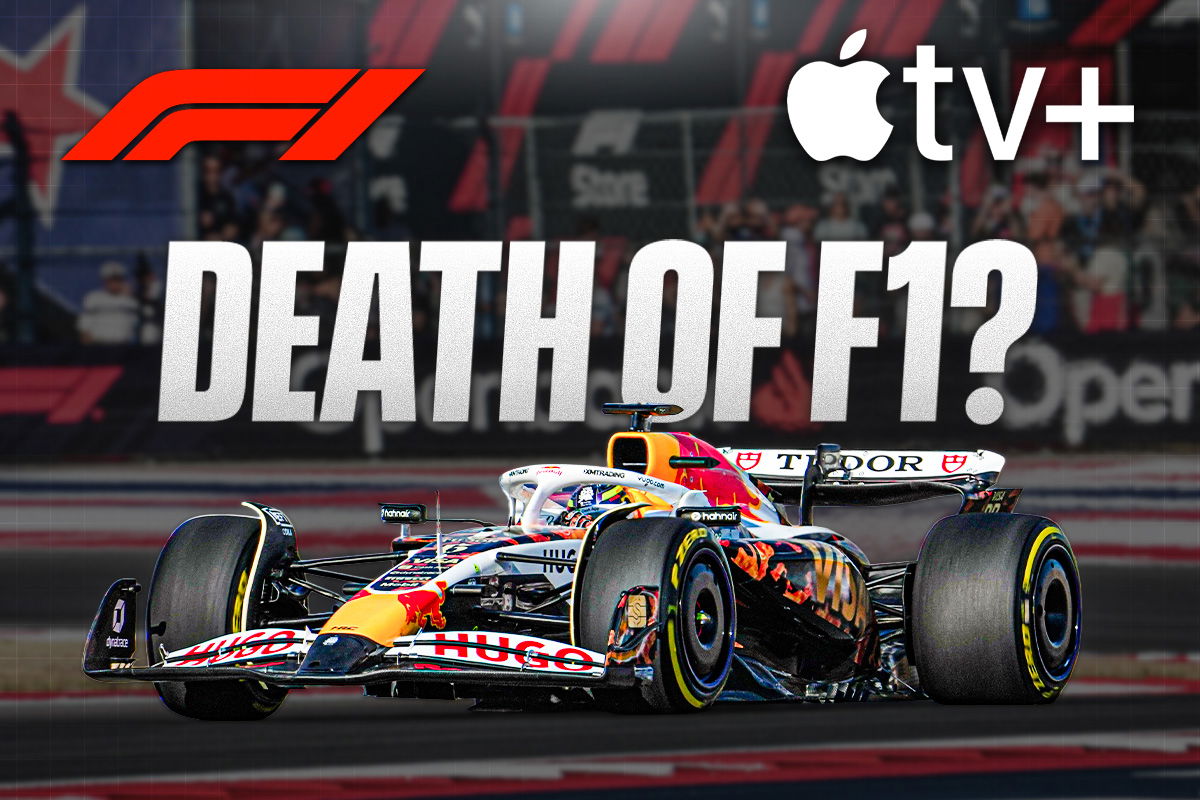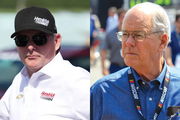
Imago
Credits: imago

Imago
Credits: imago
Imagine this: It’s a lazy Sunday morning, you are sipping your coffee, and checking the channels in search of the roar of F1.. But… nothing. No ESPN. No ABC. Rather, it is hidden behind a login screen on Apple TV+, awaiting subscription. That is the very truth in 2026, when Formula 1 will be the first big sport in the U.S. to become streaming-only.
Watch What’s Trending Now!
Now, you might wonder: why is this such a big deal? The answer lies in how other major U.S. leagues handle broadcasting. Most of them use hybrid models, mixing traditional TV with streaming platforms:
NFL: CBS, NBC, FOX, plus Amazon Prime Video
NBA: ESPN, TNT, ABC, with NBA League Pass for streaming
MLS: Apple TV+ streaming along with traditional TV
MLB: Regional sports networks, ESPN, FOX, plus MLB.TV
ADVERTISEMENT
Therefore, F1 is cutting the cord all the way, no cable, no hybrid, no backup. It’s all Apple now. But as we know, all daring initiatives come with expenses and potential threats.
Apple’s $700 million all-in bet
Let’s be honest, Apple operates without hesitation in this deal. The acquisition of all 50 practices and all qualifiers, sprint races, and Grand Prix events will cost Apple ~$600 million spread across five years, which amounts to ~$140 million annually. Apple is not merely purchasing broadcasts. It is strategizing a content ecosystem:
ADVERTISEMENT
F1 stories in Apple News
- Race playlists in Apple Music.
Maps integrating F1 circuits or fan experiences
- Racing-inspired workouts in Fitness+
In comparison, the previous deal of ESPN was estimated to cost up to ~$90 million annually, yet attracted 1.3 million American viewers, per race of 2023-24. Sure, this time Apple will be introducing deeper pockets, yet ESPN is the one with the bigger audience. And therein the actual strain has taken place.
ADVERTISEMENT
FI’s streaming math doesn’t look great
The current subscriber base of Apple TV+ in the U.S. stands at 18 million. That is a difference, to say the least, compared to the 24 million households subscribing to ESPN cable.
Let’s compare Apple with other platforms:
ADVERTISEMENT
Netflix: 81.4 million
Amazon Prime: 75 million
HBO: 62.8 million
Paramount+: 57.7 million
Hulu: 55.5 million
Disney+: 53.7 million
Peacock: 41 million
Smaller platforms continue to win more viewers than Apple TV+:
Top Stories
Bills Legend Jim Kelly Announces Final Cancer Update After Years of Battle

Robert Saleh Makes Final Decision on Head Coaching Job Away From Kyle Shanahan & 49ers

Jimmie Johnson & Co. Robbed of Millions as Court Exposes Disastrous Fallout of Jim France’s ‘No Bueno’ Decision

Calls Mount Against Refs’ Controversial Decision Involving Dak Prescott in Cowboys vs Lions TNF Game

Jeff Gordon Duped Into False Hope as NASCAR’s Blatant Lie Exposes Jim France as Culprit No. 1

After ‘Firing’ Tony Stewart, Leah Pruett Ready to Reclaim Her Title as Team’s No.1 Top Fuel Driver

Starz: 13.3 million
AMC+: 11.6 million
ADVERTISEMENT
This implies that F1 is selling mass exposure at the cost of exclusivity (in a platform with about 75% less U.S. reach), which leads to what may go wrong should the brakes fail to stop.
The early warning lights
F1 has maintained continuous growth in the United States through the following years:
ADVERTISEMENT
2023 season: averaged 1.16 million viewers
2024 season: brought a bit decrease in viewership to 1.13 million
The main issue lies in Apple TV+ reaching fewer viewers. The $12.99 monthly fee for Apple TV+ creates a barrier for casual fans who previously watched F1 on ESPN on Sunday mornings. The process of account creation and subscription management, and application setup creates an obstacle for viewers to watch content. The process of watching television turns into work, which leads people to abandon their viewing habits. The reduced viewership would lead sponsors to reconsider their deals, and American teams Haas and Andretti would face difficulties in getting noticed by fans.
ADVERTISEMENT
Even league partners may wonder if paywalled races can keep growing F1’s audience in the U.S. But unlike everyone, F1 is not panicking, because they know it is a calculated move!
The formula behind the F1’s gamble
Why did they take this gamble? Well, it was after a big win! Remember F1: The Movie. It proved to be an Apple blockbuster partnership that debuted in June on IMAX and raked in over $629 million globally prior to being available on Apple TV+ later in the month of December. And we know the two are already aware of how to win together.
ADVERTISEMENT
The Netflix effect: Drive to Survive made F1 easy to love. Because it boosted 10% more fans, and by 2023, F1 even passed NASCAR with 52 million fans.
Tech audience: F1 fans aren’t the normal fans but are digital and stats-driven. And now, partnering with Apple, it will connect the sport to News, Music, Maps, Fitness+, and Sports apps.
Eventization: Big events such as the Las Vegas Grand Prix are not merely competitive activities. Although not all races attract large crowds, these high-profile events produce enormous publicity and participation. These moments can be multiplied in the global platform of Apple and become must-watch spectacles that can generate revenue and excitement among fans.
Strategic Global Positioning: The U.S. is approximately 35 percent of the broadcast value of F1. With this second bet on streaming, F1 is not giving up on America; it is trying out the waters of how digital consumption can power new markets. In the areas where mobile-first is a rule – consider India, Japan, the Middle East – Apple infrastructure might drive F1 to completely new audiences.
And other leagues are waiting and watching…
Everyone else is watching F1
F1 is about to roll out something that will shake the entire sporting world. And other leagues? They are watching attentively.
Take the NBA. The league begins with an 11-year, $76 billion media rights deal that combines old and new, beginning in 2025:
Amazon Prime Video streams 66 regular-season games
ESPN/ABC continues to air the Finals and most regular-season games.
NBC returns to NBA broadcasting
The takeaway? The NBA is following Formula 1’s lead to get more young, tech-savvy fans by offering games on streaming services. However, they’re still keeping games on traditional TV channels for casual fans.
Other major leagues are paying close attention. The old model of local sports channels is collapsing, which is forcing leagues like NASCAR, UFC, and MLB to find new ways for fans to watch their teams. For example, MLB is now trying to stream local games directly to fans to have more control.
However, with all the leagues going digital, the question that F1 will have to face is no different: what will become of it when fans simply do not subscribe?
The safety net (just in case)
The F1 and Apple TV+ collaboration exclusive deal may seem to have been a one-way ticket to the digital future, but the sport understands that not all fans will be willing to subscribe immediately. But then, how can it remain visible even when driving at high speed into streaming?
Here is how it is possible:
- On YouTube, TikTok, ABC, and social media, the highlights and recaps remain free.
- The Las Vegas and Monaco Grand Prix are the high-profile events that are likely to be aired on traditional TV.
- Apple collaboration introduces F1 in News, Music, Maps, Fitness+, and Sports apps, and F1 TV Premium is available through Apple TV+ and Apple One packages.
Such moves keep F1 in the minds of the masses, followers, and non-followers of the pay wall. This does not just come down to where F1 is streaming in the end. It remains to be seen whether the other sports will put it into the pit lane.
If F1 nails this, others will follow the blueprint.
If it crashes, it becomes the industry’s red flag.
Either way, sports media is watching more closely than ever.
ADVERTISEMENT
ADVERTISEMENT
ADVERTISEMENT

